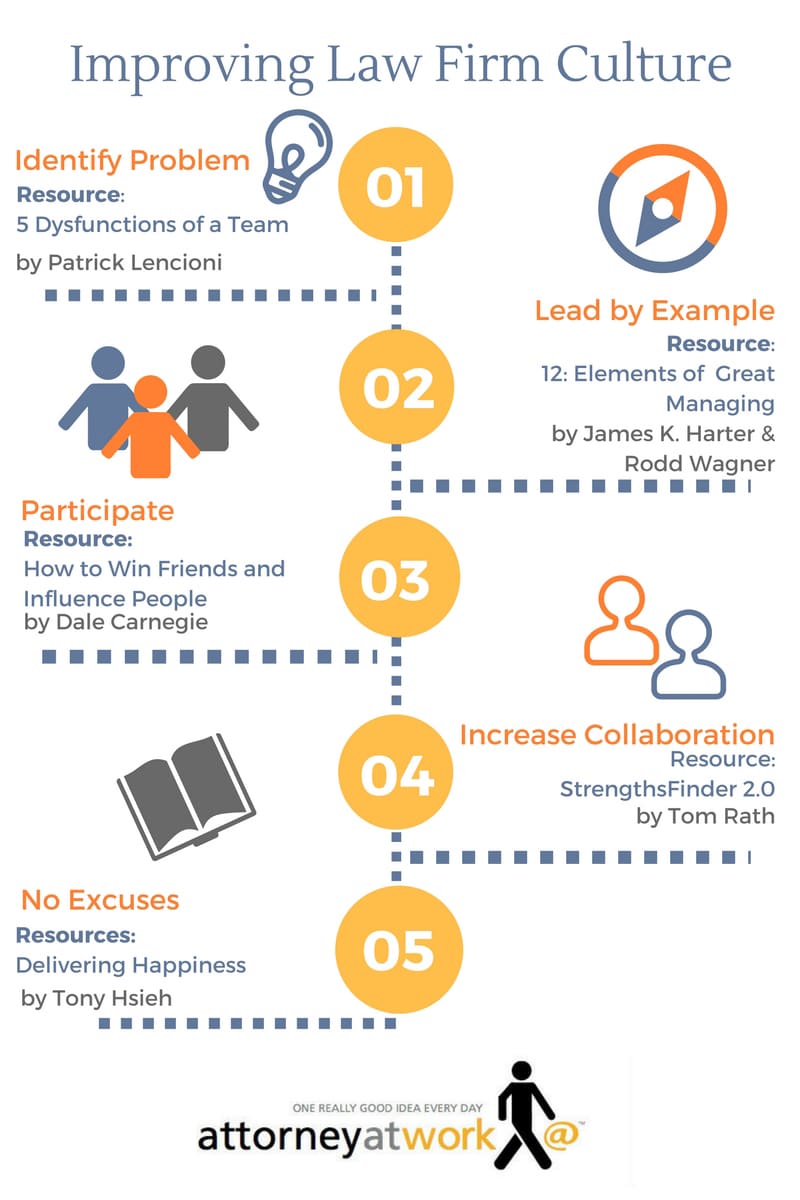Whether you practice solo with a small staff, at a midsize law firm, or in BigLaw, you can always find ways to improve your firm’s culture.
It’s true that law firms have a unique culture, regardless of size. One reason is that the billable hour limits and even stifles collaboration. (Collaboration? It’s not something lawyers are taught to think about.) But the hierarchies and structures built into the law firm model can be managed in a way that creates a positive work environment and organizational culture.
The benefits are both financial and psychological: lower turnover rates, increased productivity, an easier time recruiting new team members, increased morale and motivation, greater involvement, lower absenteeism, and even lower insurance rates.
How can you ensure that your law firm (or legal department) builds or maintains a great culture? Here are five steps and resources.
1. Find the Root Cause of the Problem
Resource: “Five Dysfunctions of a Team” by Patrick Lencioni. You don’t necessarily have to have a problem to think about how to improve your law firm’s culture — or ensure that it endures as the firm grows. A firm can lose its way as it expands, so thinking about how to maintain a great culture is a smart, proactive move. Here are some questions to ask yourselves to maintain a great culture:
- What makes our culture great? Is it transparency, the people, the communication?
- How can we maintain this every time we add a new lawyer to our team? How can we structure our interview process to ensure a great cultural fit?
On the other hand, if you’ve noticed a decline in morale, you can take steps to rectify this as quickly and painlessly as possible.
“Five Dysfunctions of a Team” does a great job of presenting a team that has its own dysfunctions in a way that’s easy to relate to. It shows how one relentlessly negative person can bring down the whole team. It forces you to think about your own team, to identify whether it’s the lack of transparency and communication or the fear of confrontation that’s causing problems, and then suggests ways to troubleshoot.
Goal: Use the book to help identify the root cause of your problem, and do some experiments of your own. Listen closely the next time your team meets to see if you can pinpoint the problem. Use the lessons from the book to address it.
2. Lead by Example
Resource: “12: The Elements of Great Managing” by James K. Harter and Rodd Wagner. Leaders are often the No. 1 reason employees leave, and the No. 1 trait of a great leader is self-awareness. If you know how you act around others, how you treat others, how you praise, or, unfortunately, degrade others, then you also know how you can improve your leadership and communication skills to ensure your best people stick around.
This is not to say that it’s all on you, but how you act can definitely impact how the rest of the team acts. If you don’t praise your team members, if you don’t care about their performance or needs, it will create a toxic environment that quickly spreads through the organization. Whether you’re a partner, paralegal, associate, or office manager, “12: The Elements of Great Managing” is a great resource. It covers the intricacies of Gallup’s Q12 survey on employee engagement.
Goal: Take the Gallup survey with your team, identify the issues, and then take steps to nip them in the bud.
3. Don’t Rely on HR or the Office Manager
Resource: “How to Win Friends and Influence People” by Dale Carnegie. While it’s easy to defer to human resources or an office manager, their efforts to improve your culture will fail if the whole team does not embrace them. Staff can develop all sorts of programs, experiments or trial runs — but if you don’t actively step up as a leader and embrace the changes, or speak up when their approach isn’t working, all their work will go to waste. And they may actually make the culture worse.
Before your firm attempts a new program or makes a change, be sure you know what your culture should be like (see No. 1). What makes your culture great? What’s most important to you and your team? Is it a safe environment, with fluid transparency and a shared belief in speaking up regardless of the consequences? If not, attempts by HR or an office manager to create an “open space” office plan, or conduct a culture survey, or have annual “360-degree” reviews may be useless because they do not coincide with your goals.
Done thoughtfully, regularly and in sync with your existing culture, 360-reviews can be great. However, if your team is small or scared to speak up, any 360-review will be useless because it won’t shed light on the problem itself. Similarly, if trust is an issue, an open floor plan will create more problems. People who don’t communicate well, to begin with, might reject being in an open environment with the people they are trying to avoid.
“How to Win Friends and Influence People” has been a best-seller for decades for a reason. It shows how every person in an organization can improve their communication skills, regardless of title or position.
Goal: Make it everyone’s job to ensure they contribute to a positive environment and communicate well.
4. Increase Collaboration
Resource: “StrengthsFinder 2.0” by Tom Rath. You may have a rock star team or practice in a highly hierarchical or structured law firm, but there are always ways to improve communication and collaboration. One of the most interesting methods is by rigorously outlining the strengths of your team. “StrengthsFinder 2.0” explains that focusing on people’s strengths, rather than their weaknesses, promotes a healthier discussion of what’s working and what isn’t.
The theory is that you can only improve on your weaknesses so much; in the long run, they will not impact your communication or productivity. However, if you focus on your strengths, you can learn to use them to your advantage and overcome your weaknesses. If you’re competitive, for example, but you’re not a great communicator, you can have a competition with a friend or co-worker to take one step per week to improve your communication, so at the end of the month, you will have the “win” you crave.
Goal: Have your team take the “StrengthsFinder 2.0” quiz, share their top five strengths, and discuss how they can collaborate by using one another’s strengths. If one team member is an “achiever” and another is “futuristic,” they can collaborate by harnessing their complementary skill sets. For example, the futuristic person can present any idea by focusing on its impact on the future of the case or firm, while the achiever can talk about the tasks that must be completed to achieve the goal.
5. Don’t Let Your Size or Geography Be an Excuse
Resource: “Remote: Office Not Required” by David Heinemeier Hansson and Jason Fried. We live in a digital world where technology makes working from … well … anywhere possible. While this mobilization has its benefits, it can make team collaboration more difficult. Likewise, in larger firms especially, closed office doors are not uncommon and there, too, collaboration is hindered. Regardless of the obstacle, there are ways to overcome and create a great collaborative culture. “Remote” (a collection of essays from the people behind Basecamp) has some insights into working remotely — particularly for making remote team members feel like they’re still involved through the use of technology.
Goal: Investigate the tactics and tools described in “Remote,” such as group conference calls, screen-sharing, and, for law firms specifically, case management systems with team calendars and activity trackers.
Don’t Forget the Happy Factor
Bonus Resource: “Delivering Happiness” by Tony Hsieh. If you’re in a midsize or large law firm, read up on Google’s strategies for building a great team. For example, creating smaller teams within a large organization can improve communication and collaboration. Zappos is another company with a great culture, known for experimenting with different strategies for improvement. In “Delivering Happiness,” CEO Tony Hsieh describes how making sure that every customer is happy with their services is a common team goal and shared internal priority. Every team member goes through the same training process regardless of title or position.
Whether you have 10 people or 10,000, there are tried-and-true methods for ensuring transparency, collaboration, and trust, to build a winning team. To name a few: Create smaller teams, experiment with onboarding strategies by having associates work with different partners each week, create a mentorship system, hold weekly meetings to collaborate on cases, sacrifice one billable hour per week to come up with unique solutions. Ultimately, focus on learning what works best for your team. The benefits will outlast the sacrifices.
Illustration ©iStockPhoto.com
























